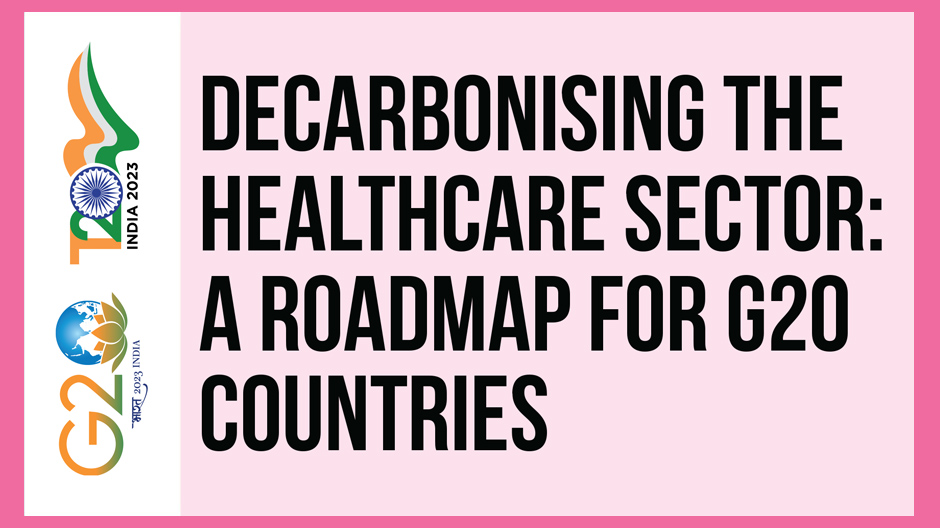Task Force 3: LIFE, Resilience and Well-being
The climate crisis is at its core a public health crisis. Timely, appropriate and comprehensive response by all nations is imperative to prevent economic and social crises associated with the growing burden of climate impacts on human health and health systems. To deliver quality healthcare, health facilities – infrastructure and supply chains – must be structurally and functionally resilient. They should neither contribute to climate change nor be impacted by it. The health workforce should be prepared for and capable of responding to climate risks and impacts. Healthcare facilities collectively contribute nearly 5 percent of global greenhouse gas (GHG) emissions, 71 percent of it coming from the supply chain.[1] To align itself to the goals of the 2015 Paris Agreement, the health sector must also decarbonise. This Policy Brief recommends that G20 countries adopt the steps outlined in the ‘Global Roadmap for Health Care Decarbonisation’[2] of the global NGO Health Care Without Harm to secure public health and achieve net-zero healthcare.
1. The Challenge
Protecting and safeguarding public health in a world 1.5 degrees C warmer than in pre-industrial times poses challenges, and the imperative is to build climate-resilient health systems equipped to deal with climate-related health crises. Acute climate events can have both direct and indirect impacts on human health, including respiratory and cardiovascular illnesses, nutrition-related disorders, vector-borne diseases, water-borne illnesses, and poor mental health resulting from post-traumatic stress disorders and climate migration.[3] Simultaneously, health systems also need to reduce their own environmental health impacts by decarbonising healthcare service delivery.
Healthcare contributes nearly 5 percent of global GHG emissions. G20 countries are responsible for more than 75 percent of such emissions, the principal contributors being the US (27 percent), China (17 percent), the EU (12 percent), Japan (5 percent), and Russia (4 percent), while Brazil, India, South Korea, Canada and Australia contribute about 2 percent each.
Urgent decarbonisation is critical, but the trajectory and momentum of action need not be the same for all G20 countries. High-income countries such as the US, the EU group, Australia or Canada need to set immediate targets, while India and other low- and middle-income countries, where universal healthcare is yet to be achieved, could follow a different course. However, all countries must close in on net-zero healthcare emissions by 2050.
This differential momentum proposed for healthcare decarbonisation in different countries is based on the following premises:
- Not all countries have achieved optimum healthcare access and utilisation targets;
- Different regions have unequal contributions to legacy GHG emissions;
- The UN Framework Convention on Climate Change’s (UNFCCC) principle of “common but differentiated responsibilities, and respective capabilities” should apply to the health sector as well.
Given the differential health impacts of climate change, low- and middle-income countries are often the most vulnerable. Thus all nations need to rapidly establish and sustain resilient and low-carbon health systems.
Emissions are produced across all aspects of healthcare operations. They include facility-level emissions from service delivery (Scope 1), emissions produced while utilising the energy purchased from external grids (Scope 2) and, most of all, emissions from the supply chain, including the manufacture, supply, use and disposal of healthcare goods and services (Scope 3) which are responsible for about 70 percent of health sector emissions globally (see Fig.1). Interventions to address Scope 3 emissions are therefore needed both within health facilities via sustainable procurement practices and in domains beyond their purview.
Figure 1: Global Health Sector GHG Emissions
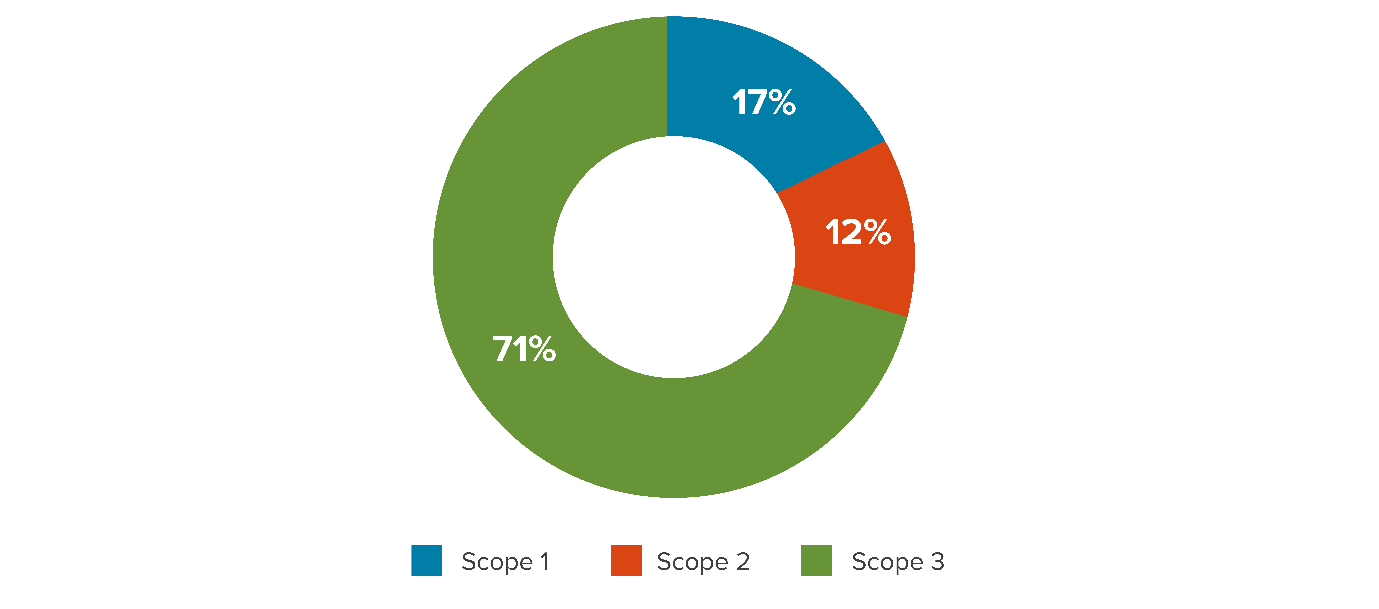
Source: HCWH, Health Care’s Climate Footprint
Note: SCOPE 1 – Take immediate action to reduce healthcare facility emissions.
SCOPE 2 – Invest in and advocate decarbonisation of local and national energy systems and use of clean, renewable energy.
SCOPE 3 – Set and implement criteria for low-carbon or zero-emissions procurement so as to begin to decarbonise the supply chain
At the level of a single facility, emissions arise from a spectrum of activities that include use of resources such as buildings, energy for heating, cooling, lighting, water, waste management and transport (see Fig. 2). The proportions depend on the size of the facility and workforce, the nature of services delivered, the number of beds, and the patient flow. Healthcare delivery is intricately linked to, and dependent on, other sectors that also contribute to its climate footprint.
Figure 2: Global Healthcare Emissions by Production Sector
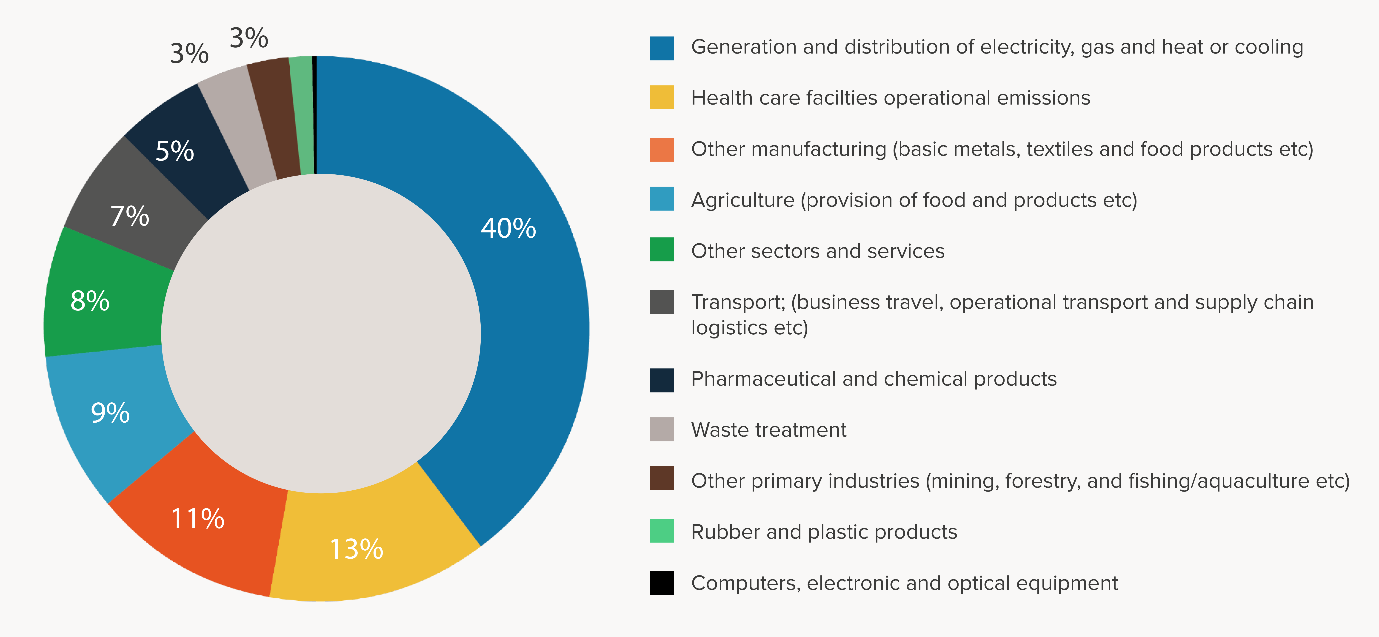
Source: HCWH, Health Care’s Climate Footprint[4]
2. The G20’s Role
The momentum for healthcare decarbonisation is building. At the UNFCCC Conference of the Parties (COP26) in Glasgow in November 2021, 52 countries committed to transition to low-carbon and climate-resilient healthcare. Today, the number has risen to over 65, all of whom have joined WHO’s coordinated programme, Alliance for Transformative Action on Climate and Health (ATACH),[6] and are working together to decarbonise healthcare and build climate-resilient health systems. More than 20 of these countries have committed to net-zero healthcare by 2050 or earlier.
In a communiqué in May 2022, the G7 nations[a] declared their aim to “build environmentally sustainable and climate-neutral health systems at the latest by 2050 and to support other countries in this effort.”
Figure 3: Top 10 Emitters and All Other Nations (% of Global Healthcare Footprint)
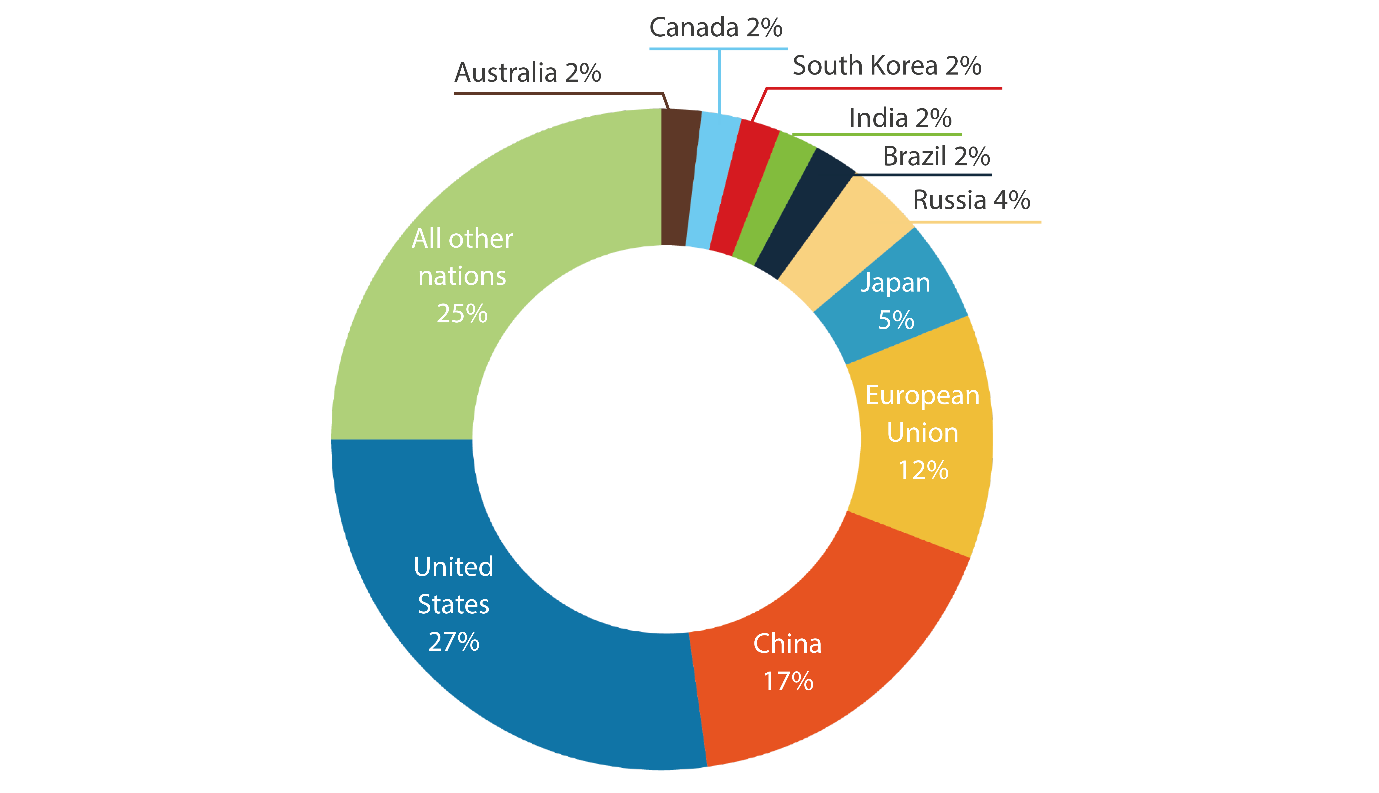
Source: HCWH, Health Care’s Climate Footprint[7]
In April 2023, the G20 Secretariat, India’s Ministry of Health and Family Welfare, and the Asian Development Bank (ADB), at the second G20 Health Working Group meeting in Goa proposed five high-level principles for healthcare climate action:[8]
- Prioritise climate-resilient health development.
- Build sustainable and low-carbon health systems that deliver high-quality healthcare.
- Decarbonise the healthcare supply chain.
- Mobilise finance for resilient, low-carbon, sustainable health systems.
- Facilitate collaboration on human, animal, and climate health challenges.
These principles are guided by a cross-cutting ‘One Health’ approach which recognises that people’s health is intertwined with that of other living beings and our shared environment. The first four principles align with the four thematic working areas of the WHO-led ATACH. The ADB has also proposed a
collaboration with the Government of India to establish a Climate Change and Health hub to leverage financial investments, partnerships, and knowledge to implement these principles.[9]
The health ministries of the G20 nations need to collectively commit to focused actions to achieve low-carbon or net-zero healthcare. Actions taken will help reduce the health sector’s carbon footprint to a considerable degree, and set it on the path to a net-zero sustainable sector.
Approach
The Health Care Without Harm’s ‘Global Roadmap for Health Care Decarbonisation’[10] is based on an in-depth analysis of healthcare emissions and more than a decade’s worth of insights and case studies from the Global Green and Healthy Hospitals network (GGHH).[11],[12],[13] It provides clear guidelines on how to achieve net-zero healthcare worldwide, and shows how healthcare can significantly reduce its emissions to align with the goals of the Paris Agreement (see Fig. 4).
Figure 4: Approach to Healthcare Decarbonisation

Source: HCWH, Global Roadmap for Health Care Decarbonisation[14]
The Global Roadmap for Health Care Decarbonisation[15] outlines three pathways and seven high-impact actions to transition to net-zero (Figures 5 and 6).
The three pathways to healthcare decarbonisation
Pathway 1: Decarbonise healthcare delivery, facilities, and operations. Hospitals and health systems must implement interventions that will ultimately fully decarbonise every aspect of healthcare delivery and its supporting functions while maintaining and improving patient care.
Pathway 2: Decarbonise healthcare supply chain. This includes reducing direct emissions from the production of grid electricity purchased by healthcare facilities, as well as emissions during the manufacturing, packaging, and transport of products used in the health sector. Health systems can take joint procurement decisions and pool their purchasing power to aggregate demand for purchase of sustainably produced goods and services.
Pathway 3: Accelerate decarbonisation in the wider economy. Every aspect of the healthcare supply chain and delivery relies on other industries that provide energy, chemicals, building materials, packaging, infrastructure, transport, food, and more. Wider societal decarbonisation is crucial to the health sector achieving net-zero emissions.
To achieve net-zero emissions, the sector must follow these three interwoven pathways simultaneously.
Figure 5: Pathways to Net-Zero Healthcare
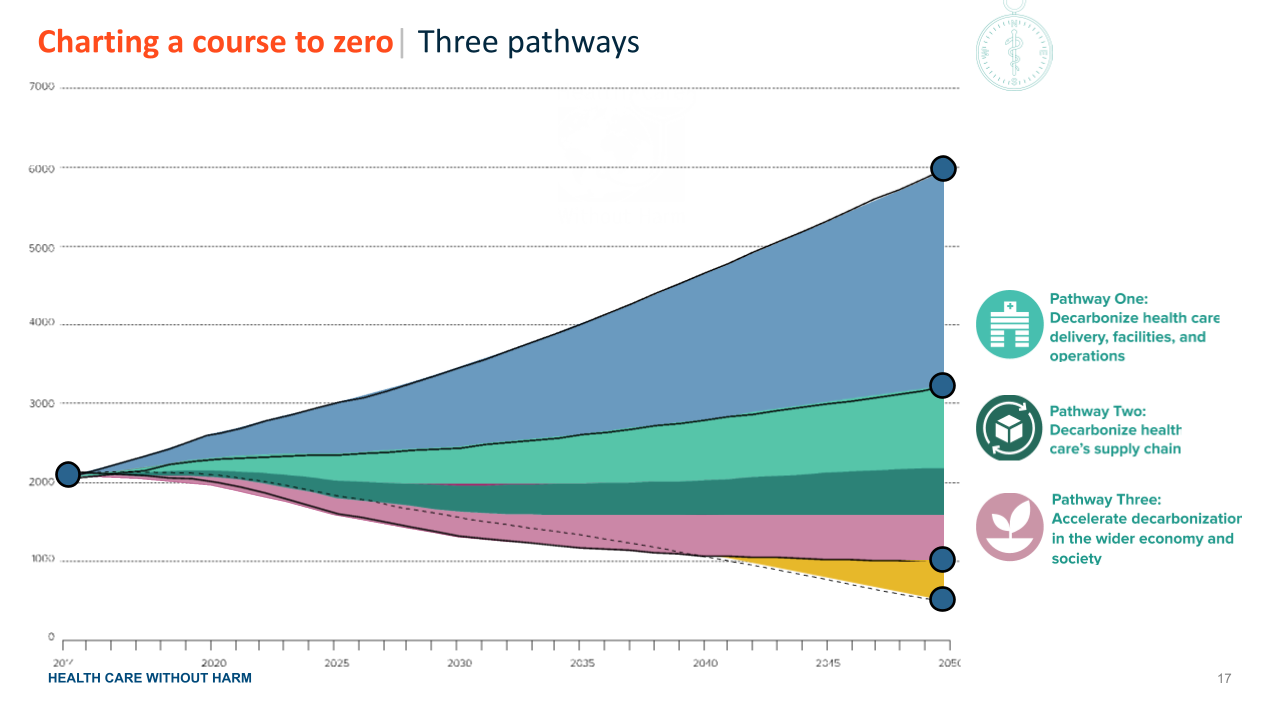
Source:HCWH, Global Roadmap for Health Care Decarbonisation[16]
- Power healthcare with 100-percent clean, renewable electricity.
- Invest in zero-emissions buildings and infrastructure. Ensure every healthcare building and health product manufacturing facility and its infrastructure promotes energy efficiency and climate resilience.
- Transition to zero-emission travel and travel infrastructure. Encourage patients and staff to use public transport wherever feasible
- Provide healthy, sustainably grown food with zero food waste.
- Incentivise production of low-carbon pharmaceuticals. Reduce unnecessary pharmaceutical use, substitute high-emissions products with more climate-friendly alternatives, and incentivise the production of affordable climate-smart medicine.
- Implement circular healthcare and sustainable healthcare waste management. Procure sustainable supplies, deploy clean technologies, reduce the volume and toxicity of healthcare waste, and manage waste sustainably.
- Establish greater health system effectiveness: Eliminate inefficient and unnecessary practices, link carbon reduction to quality of care, and bolster resilience.
Fig. 6: High-Impact Actions to Reduce Health Sector Emissions (2014-2050)

Source: HCWH, Global Roadmap for Health Care Decarbonisation[17]
Note: This figure details the segmentation of the grey wedge shown in Figure 4.
Achievements So Far
The methodology set out in the global roadmap has now been implemented at the national level in Portugal[18] and is in process in the Netherlands. G20 nations can use it to develop their own net-zero healthcare plans.[19]
The UK’s National Health System (NHS) has committed to establishing the world’s first net-zero health service. On 1 July 2022, the UK became the first country to embed ‘net zero’ into legislation, through its Health and Care Act 2022.
3. Recommendations to the G20
By endorsing the proposed High-Level Principles for Health Care Climate Action, the G20 can align itself to WHO’s ATACH. Its commitments would then impact more than 75 percent of total global health sector GHG emissions. The principles can be implemented through the recommended set of seven high-impact actions across the three pathways. G20 nations can thereby transition their health sectors to net-zero healthcare, setting an example for the rest of the world. This will require investment, but early investment in climate adaptation and mitigation will help avert costly damages and reparations later.
The global roadmap provides country-level fact sheets for nearly 70 countries laying down the principles for country-level roadmaps towards health sector decarbonisation. The fact sheets provide information on each country’s health sector emissions with recommendations to net-zero emissions healthcare.
Case Study: India
Decarbonising the Indian health sector will require a country roadmap. Various scenarios will need to be considered (Fig. 7) as India has yet to develop a GHG inventory for its health sector. The HCWH estimates that currently India’s health sector accounts for about 1.5 percent of its total emissions. Given that India in its NDC has committed to reduce emissions intensity of its GDP by 33-35 percent by 2030, every sector, including healthcare, needs to contribute. Health sector emissions are estimated at around 39 million tCO2e per year, equivalent to the emissions from 10 coal power plants.[20]
Fig. 7. Pathway for Health Sector Emissions Reduction in India
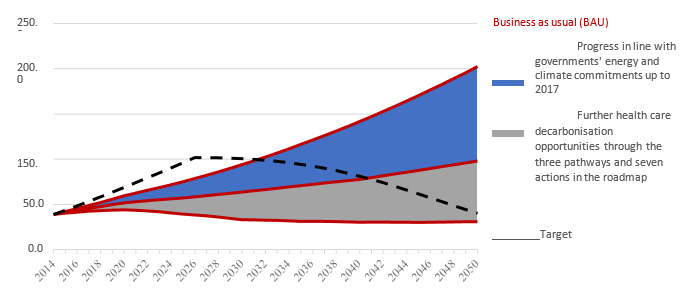
Source: HCWH, Global Roadmap for Health Care Decarbonisation [21]
Note: The topmost line (red) shows forecast of emissions growth if there is no further climate action. Overlaid are two estimates for potential decarbonisation. Also shown is the national target trajectory (broken line)
Fig. 8 Per Capita Emissions Target Trajectories Across Nations, by Decarbonisation Trajectory
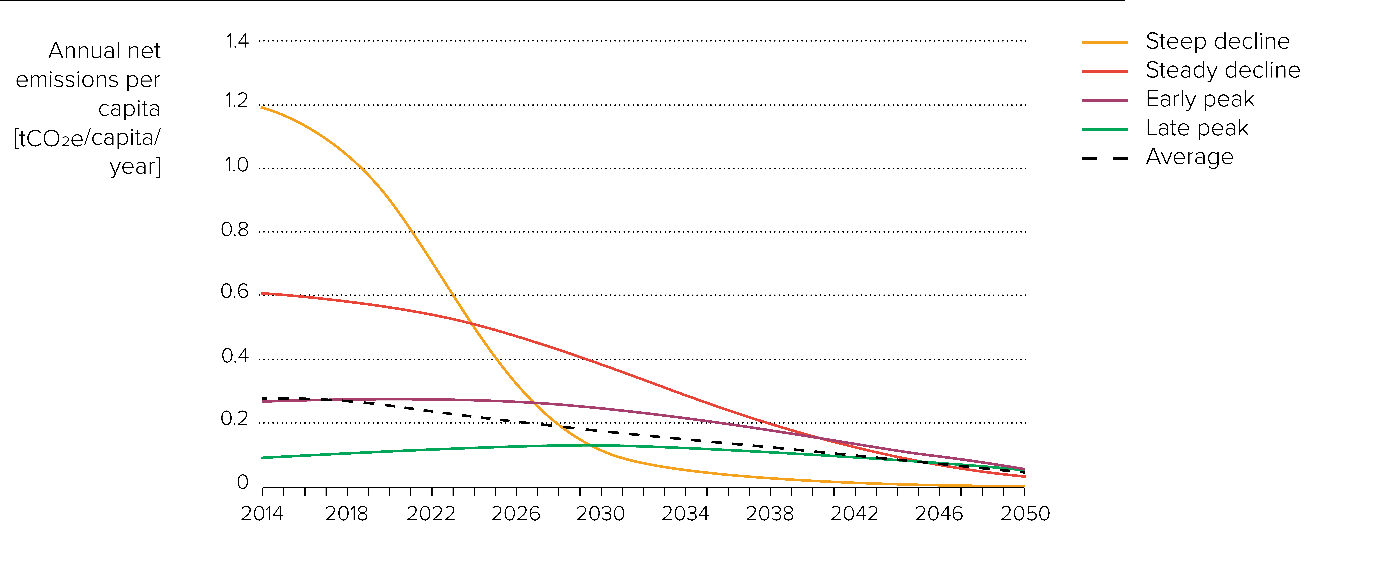
Source: HCWH, Global Roadmap for Health Care Decarbonisation[22]
Achieving any one of these trajectories will require all health systems to immediately change course toward zero emissions. The roadmap establishes trajectories requiring a steep or steady decline in emissions by the health sectors of the wealthiest and biggest polluting countries, while allowing room for an increase in emissions that peak between 2023 and 2030 in low- and middle-income countries.
India is assigned to the ‘late peak’ trajectory, which calls for immediate action to change course and begin implementing decarbonisation strategies while working towards green universal healthcare.
Specific Recommendations
- All G20 nations should endorse the proposed G20 High-Level Principles for Health Care Climate Action to achieve climate-resilient, low-carbon healthcare operations and supply chain, while financing the transition of health systems around the world.Actions required: Embed the High-Level Principles as a priority area of the G20 Health Working Group under India’s G20 Presidency and going forward as Brazil assumes the G20 Presidency.
- Join the WHO-led Alliance for Transformative Action on Climate and Health to collectively build climate resilient and sustainable health systems.Actions required: All G20 members should join the WHO-led ATACH that seeks to guide countries in creating strategies to achieve net-zero healthcare.
- Include health and healthcare decarbonisation plans in each country’s NDCs and in national and sub-national climate policies. So far, only 10 percent of NDCs refer to health impacts of climate change. Develop national healthcare decarbonisation plans, drawing on the Global Roadmap for Healthcare Decarbonisation to chart a course to net-zero.Actions required: Use the global decarbonisation roadmap and country-level guidance to develop national roadmaps through specific baseline mapping of current climate footprint and interventions so far.
- Invest in further research; set up climate and health innovation centres to facilitate and deepen emission reduction across the sector.Actions required: Every country should conduct a landscape analysis and provide resources for a needs-based allocation of research and innovation funding.
- Strengthen the health workforce to both address the health impacts of climate change and deliver sustainable healthcare.Actions required: Sensitise health professionals (doctors, nurses and allied health professionals) to lead actions to achieve net-zero healthcare.
Attribution: Poornima Prabhakaran, Fiona Armstrong and Josh Karliner, “Decarbonising the Healthcare Sector: A Roadmap for G20 Countries,” T20 Policy Brief, June 2023.
Endnotes
[a] These are Canada, France, Germany, Italy, Japan, the UK and the US.
[1] Josh Karliner, Scott Slotterback, Richard Boyd, Ben Ashby and Kristian Steele Health Care’s Climate Footprint: How the Health Sector Contributes to the Global Climate Crisis and Opportunities for Action (Health Care Without Harm and Arup, 2019)
[2] Josh Karliner, Sonia Roschnik, Richard Boyd, Ben Ashby and Kristian Steele, Global Roadmap for Health Care Decarbonisation: A Navigational Tool for Achieving Zero Emissions With Climate Resilience and Health Equity (Health Care Without Harm, 2021)
[3] A Haines and JA Patz, “Health Effects of Climate Change,” JAMA 2004 Jan 7; 291(1):99-103. doi: 10.1001/jama.291.1.99. PMID: 14709582.
[4] Karliner et al., Healthcare’s Climate Footprint, 2019
[5] Karliner et al., Global Roadmap for Health Care Decarbonisation 2021
[6] Alliance for Transformative Action on Climate and Health 2021.
[7] Karliner et al., Healthcare’s Climate Footprint, 2019
[8] Asian Development Bank, G20 Secretariat, Government of India Ministry of Health and Family Welfare. “Briefing document: addressing the challenges of climate change and health, one earth, one family, one future,” G20 Health Working Group Side Event, Goa, India. April 20, 2023. Manila: Asian Development Bank, 2023.
[9] Josh Karliner et al., “Momentum Builds for Health-Care Climate Action,” The Lancet, D-23-02454 S0140-6736(23)01079-6, May 31, 2023.
[10] Karliner et al., Global Roadmap for Health Care Decarbonisation 2021
[11] Global Green and Healthy Hospitals, accessed on 28 May 2023,
[12] Case studies on climate resilient health care facilities, accessed on 28 May 2023.
[13] Case studies on climate resilient health care facilities, accessed on 28 May 2023.
[14] Karliner, et al., Global Roadmap for Health Care Decarbonisation 2021
[15] Karliner, et al., Global Roadmap for Health Care Decarbonisation 2021
[16] Karliner, et al., Global Roadmap for Health Care Decarbonisation 2021
[17] Karliner, et al., Global Roadmap for Health Care Decarbonisation 2021
[18] Portugal Operation Zero Report Carbon footprint of the portuguese health sector and ways for mitigation.
[19] Health Care Without Harm, “Designing a Net Zero Roadmap for Healthcare”.
[20] Karliner et al., Global Roadmap for Health Care Decarbonisation 2021
[21] Karliner, et al., Global Roadmap for Health Care Decarbonisation 2021
[22] Karliner, et al., Global Roadmap for Health Care Decarbonisation 2021



